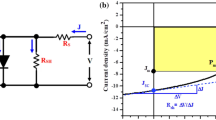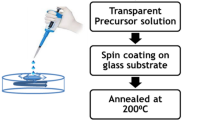Abstract
This study aims to prepare transparent defective p-type TiO2 films using defects chemistry via the hydrothermal method, showing that the metal vacancies (VTi) may be easily presented into undoped oxide, then constructing a p-n homojunction diode. The defective TiO2 depicts the p-type conductivity with a high charge mobility which was verified via the Hall Effect measurement. The influence of growth time upon the TiO2 nanorods' morphological, structural, and optical properties was investigated and analyzed using Field Emission Scanning Electron Microscopy (FESEM), X-ray Diffraction (XRD), X-Ray Photoelectron Spectroscopy (XPS), and ultraviolet–visible spectroscopy methods (UV–VIS). The measurements of XPS were utilized for investigating the chemical conditions of the constituent elements and the XRD analysis of deposited films for (24 h) at (180 °C) have confirmed the formation of the polycrystalline-tetragonal phase anatase as a major phase with a minor rutile phase. The FESEM measurements of TiO2 films evinced the grass shape nanostructure with a diameter range (of 26–76) nm for the prepared films with different growth times. The stoichiometry ratio of (Ti) and (O) in TiO2 films was confirmed by (EDX) analysis to be 2:1. Optical properties have been investigated, the transmittance, absorbance, and energy gap at various growth times were measured and computed, and the results manifested that the rod length reduced the transmittance, while it augmented the absorbance with slight change in the energy gap, the PL intensity of defective p- type TiO2 smaller than of n-type. The p-n homo-junction demonstrated the distinct diode-like behavior with ideality factor n = 32.069. These findings could have far-reaching consequences for the development of nanostructured metal-oxide solar cells, photo-catalysts, LEDs, photodiodes, and photo-electrochemical devices.













Similar content being viewed by others
Data and code availability
All data generated or analyzed during this study are available from the corresponding author upon reasonable request.
References
Akhter, P., Arshad, A., Saleem, A., Hussain, M.: Recent development in non-metal-doped titanium dioxide photocatalysts for different dyes degradation and the study of their strategic factors: a review. Catalysts 12(11), 1331 (2022). https://doi.org/10.3390/catal12111331
Al-Jawad, S.M.H., Mohammad, M.R., Imran, N.J.: Immersion time and annealing temperature effect on TiO2 thin films deposited by hydrothermal method. J Al-Nahrain Univ - Sci. 20(3), 67–76 (2017). https://doi.org/10.22401/juns.20.3.11
Al-Jawad, S.M.H., Salman, O.N., Yousif, N.A.: Influence of growth time on structural, optical and electrical properties of TiO2 nanorod arrays deposited by hydrothermal method. Surf. Rev. Lett. 26(3), 1–9 (2019). https://doi.org/10.1142/S0218625X1850155X
AL-Jawad SMH, Taha AA, Salim MM,: Synthesis and characterization of pure and Fe doped TiO2 thin films for antimicrobial activity. Optik (stuttg). 142, 42–53 (2017). https://doi.org/10.1016/j.ijleo.2017.05.048
Al-Maiyaly, B.K.H., Khudayer, I.H., Alrazak, A.H.A.: Effect of thickness on the electrical conductivity and hall effect measurements of (CIGS) films. Ibn Al-Haitham J. Pure Appl. Sci. 27(3), 300–308 (2014)
Anitha, V.C., Banerjee, A.N., Joo, S.W.: Recent developments in TiO2 as n- and p-type transparent semiconductors: synthesis, modification, properties, and energy-related applications. J. Mater. Sci. 50(23), 7495–7536 (2015). https://doi.org/10.1007/s10853-015-9303-7
Banerjee, A.N.: The design, fabrication, and photocatalytic utility of nanostructured semiconductors: focus on TiO2-based nanostructures. Nanotechnol. Sci. Appl. 4(1), 35–65 (2011). https://doi.org/10.2147/NSA.S9040
Bhowmik, B., Dutta, K., Bhattacharyya, P.: An efficient room temperature ethanol sensor device based on p-n Homojunction of TiO2 nanostructures. IEEE Trans. Electron Dev. 66(2), 1063–1068 (2019). https://doi.org/10.1109/TED.2018.2885360
Cao, J., Zhang, Y., Liu, L., Ye, J.: A p-type Cr-doped TiO2 photo-electrode for photo-reduction. Chem. Commun. 49(33), 3440–3442 (2013). https://doi.org/10.1039/c3cc40394g
Das, A., Palit, M., Paul, S., et al.: Investigation of the electrical switching and rectification characteristics of a single standalone n-type ZnO-nanowire/p-Si junction diode. Appl. Phys. Lett. 105(8), 083106 (2014). https://doi.org/10.1063/1.4893944
Das, A., Kushwaha, A., Sivasayan, R.K., et al.: Temperature-dependent electrical characteristics of CBD/CBD grown n-ZnO nanowire/p-Si heterojunction diodes. J. Phys. D Appl. Phys. 49(14), 145105 (2016). https://doi.org/10.1088/0022-3727/49/14/14510
Das, A., Saha, R., Guhathakurata, S., Pal, S., Ranjan, N.: Tuning of transport properties of the double-step chemical bath deposition grown zinc oxide ( ZnO ) nanowires by controlled annealing : an approach to generate p-type ZnO nanowires. Thin Solid Films 649, 129–135 (2018). https://doi.org/10.1016/j.tsf.2018.01.036
Dubey, R.S., Singh, S.: Investigation of structural and optical properties of pure and chromium doped TiO2 nanoparticles prepared by solvothermal method. Results Phys. 7, 1283–1288 (2017). https://doi.org/10.1016/j.rinp.2017.03.014
Dupin, J.C., Gonbeau, D., Vinatier, P., Levasseur, A.: Systematic XPS studies of metal oxides, hydroxides and peroxides. Phys. Chem. Chem. Phys. 2(6), 1319–1324 (2000). https://doi.org/10.1039/a908800h
Gan, Y.X., Jayatissa, A.H., Yu, Z., Chen, X., Li, M.: Hydrothermal Synthesis of Nanomaterials. J. Nanomater. 2020, 1–3 (2020). https://doi.org/10.1155/2020/8917013
Gupta, R.K., Ghosh, K., Kahol, P.K.: Fabrication and electrical characterization of Au/p-Si/STO/Au contact. Curr. Appl. Phys. 9(5), 933–936 (2009). https://doi.org/10.1016/j.cap.09.007
Haider, A.J., Najim, A.A., Muhi, M.A.H.: TiO2/Ni composite as antireflection coating for solar cell application. Opt. Commun. 370, 263–266 (2016). https://doi.org/10.1016/j.optcom.03.034
Haider, A.J., Thamir, A.D., Najim, A.A., Ali, G., A,: Improving efficiency of TiO2 Ag /Si solar cell prepared by pulsed laser deposition. Plasmonics 12(1), 105–115 (2017). https://doi.org/10.1007/s11468-016-0235-0
Hu, B., Tang, Q., He, B., Lin, L., Chen, H.: Mesoporous TiO2 anodes for efficient dye-sensitized solar cells: an efficiency of 9.86% under one sun illumination. J Power Sources. 267, 445–451 (2014). https://doi.org/10.1016/j.jpowsour.05.119
Khan, M.I., Bhatti, K.A., Qindeel, R., Althobaiti, H.S., Alonizan, N.: Structural, electrical, and optical properties of multilayer TiO2 thin films deposited by sol–gel spin coating. Results Phys. 7, 1437–1439 (2017). https://doi.org/10.1016/j.rinp.2017.03.023
Kumar, N.S., Kumar, S.K.N., Yesappa, L.: Structural, optical and conductivity study of hydrothermally synthesized TiO2 nanorods. Mater. Res. Express. 7(1), 015071 (2020). https://doi.org/10.1088/2053-1591/ab691f
Li, X., Wu, S., Hu, P., et al.: Structures and magnetic properties of p -type Mn: TiO2 dilute magnetic semiconductor thin films. J. Appl. Phys. 106(4), 043913 (2009). https://doi.org/10.1063/1.3204493
Li, X., Guo, Z., He, T.: The doping mechanism of Cr into TiO2 and its influence on the photocatalytic performance. Phys. Chem. Chem. Phys. 15(46), 20037–20045 (2013). https://doi.org/10.1039/c3cp53531b
Na-Phattalung, S., Smith, M.F., Kim, K., et al.: First-principles study of native defects in anatase TiO2. Phys. Rev. B – Condens. Matter. Mater. Phys. 73(12), 1–6 (2006). https://doi.org/10.1103/PhysRevB.73.125205
Pan, L., Wang, S., Xie, J., et al.: Constructing TiO2 p-n homojunction for photoelectrochemical and photocatalytic hydrogen generation. Nano Energy 28, 296–303 (2016). https://doi.org/10.1016/j.nanoen.2016.08.054
Prathan, A., Sanglao, J., Wang, T., et al.: Controlled structure and growth mechanism behind hydrothermal growth of TiO2 nanorods. Sci Rep. 10(1), 1–11 (2020). https://doi.org/10.1038/s41598-020-64510-6
Rajeswari, R., Venugopal, D., George, A., Dhayal Raj, A.: Design, construction and performance of P-N junction diode prepared with FeTiO2 thin films. Mater. Lett. 281, 128604 (2020). https://doi.org/10.1016/j.matlet.2020.128604
Rathore, N., Kulshreshtha, A., Shukla, R.K., Sharma, D.: Study on morphological, structural and dielectric properties of sol-gel derived TiO2 nanocrystals annealed at different temperatures. Phys. B Condens. Matter. 582, 411969 (2019). https://doi.org/10.1016/j.physb.411969
Saleh, R., Salman, O., Dawood, M.: Physical investigations of titanium dioxide nanorods film prepared by hydrothermal technique. J. Appl. Sci. Nanotechnol. 1(3), 32–41 (2021). https://doi.org/10.53293/jasn.2021.3513.1024
Salman, O.N., Dawood, M.O., Ali, A.K., Ahmed, D.S., Hassoon, K.I.: Low cost synthesis of ZnO nano thin films by electrochemical deposition. Dig. J. Nanomater. Biostruct. 12(3), 719–726 (2017)
Salman, O.N., Ismail, M.M., Ali, T.H.: Growth time influence on optical and electrical properties of TiO2 nanorods prepared via hydrothermal method. J. Phys. Conf. Ser. 2114(1), 012063 (2021). https://doi.org/10.1088/1742-6596/2114/1/012063
Sarkar, A., Khan, G.G.: The formation and detection techniques of oxygen vacancies in titanium oxide-based nanostructures. Nanoscale 11(8), 3414–3444 (2019). https://doi.org/10.1039/c8nr09666j
Wang, R., Sakai, N., Fujishima, A., Watanabe, T., Hashimoto, K.: Studies of surface wettability conversion on TiO2 single-crystal surfaces. J. Phys. Chem. B 103(12), 2188–2194 (1999). https://doi.org/10.1021/jp983386x
Wang, S., Pan, L., Song, J.J., et al.: Titanium-defected undoped anatase TiO2 with p-type conductivity, room-temperature ferromagnetism, and remarkable photocatalytic performance. J. Am. Chem. Soc. 137(8), 2975–2983 (2015). https://doi.org/10.1021/ja512047k
Wei, Z., Li, R., Huang, T., Yu, A.: Fabrication of morphology controllable rutile TiO2 nanowire arrays by solvothermal route for dye-sensitized solar cells. Electrochim. Acta. 56(22), 7696–7702 (2011). https://doi.org/10.1016/j.electacta.2011.06.038
Wu, S.M., Liu, X.L., Lian, X.L., et al.: Homojunction of oxygen and titanium vacancies and its interfacial n–p effect. Adv. Mater. 30(32), 1–7 (2018). https://doi.org/10.1002/adma.201802173
Zhang, J., Xu, Q., Feng, Z., Li, M., Li, C.: Importance of the relationship between surface phases and photocatalytic activity of TiO2. Angew Chemie. 120(9), 1790–1793 (2008). https://doi.org/10.1002/ange.200704788
Zheng, Z., Huang, B., Lu, J., et al.: Hydrogenated titania: Synergy of surface modification and morphology improvement for enhanced photocatalytic activity. Chem. Commun. 48(46), 5733–5735 (2012). https://doi.org/10.1039/c2cc32220j
Acknowledgements
Not Applicable.
Author information
Authors and Affiliations
Contributions
ASJ did the experiments, gathered the data, and wrote the whole manuscript. ONS contribute in analyzing the whole analysis and used references to support claims, and also helped with experimental parts.
Corresponding author
Ethics declarations
Conflict of interest
The authors declare no competing interests.
Ethical approval
Not Applicable.
Additional information
Publisher's Note
Springer Nature remains neutral with regard to jurisdictional claims in published maps and institutional affiliations.
Rights and permissions
Springer Nature or its licensor (e.g. a society or other partner) holds exclusive rights to this article under a publishing agreement with the author(s) or other rightsholder(s); author self-archiving of the accepted manuscript version of this article is solely governed by the terms of such publishing agreement and applicable law.
About this article
Cite this article
Jasim, A.S., Salman, O.N. Hydrothermally native defect induced transparent p-n TiO2 homojunction diode. Opt Quant Electron 55, 702 (2023). https://doi.org/10.1007/s11082-023-04984-6
Received:
Accepted:
Published:
DOI: https://doi.org/10.1007/s11082-023-04984-6




